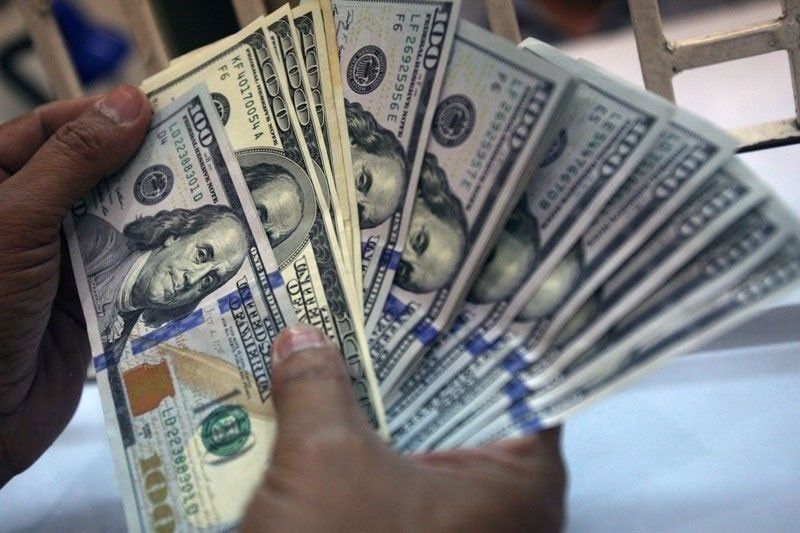Foreign debt eases to $107.7 billion in June

MANILA, Philippines — The country’s external debt eased by 1.9 percent to $107.69 billion in end-June from a record level of $109.18 billion in end-March, according to data released by the Bangko Sentral ng Pilipinas (BSP).
This translated to a lower external debt-to-gross domestic product (GDP) ratio of 26.8 percent in end-June from the end-March level of 27.5 percent.
“The ratio remains one of the lowest as compared to other ASEAN member countries. The low external debt to GDP ratio, a solvency indicator, indicates the country’s sustained strong position to service foreign borrowings in the medium to long-term,” BSP Governor Felipe Medalla said in a statement.
According to the BSP, the decrease in the debt level during the second quarter was mainly due to negative foreign exchange revaluation of $2 billion as the greenback strengthened against other currencies amid the Russia-Ukraine war and the US Federal Reserve’s recent policy actions to raise interest rates to curb inflation.
The central bank added that the transfer of Philippine debt papers issued offshore to residents from non-residents of $613 million and net repayments of $86 million further contributed to the decline in the debt level, reducing the effect of prior periods’ adjustments of $598 million.
Despite the quarter-on-quarter decline, the country’s foreign obligations inched up by 6.4 percent from $101.18 billion in end-June last year as the national government borrowed more to fund COVID-19 response measures and bankroll much needed infrastructure projects.
The $6.51 billion increase was driven by net availments amounting to $12.5 billion, largely by the national government, and prior periods’ adjustments of $2.8 billion.
Meanwhile, the transfer of Philippine debt papers to residents from non-residents of $5 billion as well as the negative foreign exchange revaluation of $3.8 billion partially tempered the increase in the debt stock.
The country’s external debt has been steadily rising from $73.1 billion in 2017, $78.96 billion in 2018, $83.62 billion in 2019, $98.49 billion in 2020, and $106.43 billion in 2021 as the government borrowed more from foreign creditors to finance the widening budget deficit amid the COVID-19 pandemic.
Data showed the country’s gross international reserves (GIR) level stood at $100.9 billion as of end-June, equivalent to 7.3 times cover of the short-term debt.
The Philippines emerged from the pandemic-induced recession with a GDP growth of 5.7 percent last year, reversing the 9.6 percent contraction in 2020, as the economy stalled due to strict COVID-19 protocols and lockdown measures.
The rebound was sustained with a stronger-than-expected GDP expansion of 7.8 percent in the first half of the year despite the slowdown to 7.4 percent in the second quarter from 8.2 percent in the first quarter.
The country’s debt service ratio dropped to five percent from 9.5 percent due to lower repayments accompanied by higher receipts.
Data showed public sector external debt declined by 2.5 percent to $65.7 billion in end-June from $67.4 billion in end-March, accounting for 61 percent of the country’s foreign debt.
The national government accounted for 87.8 percent or $57.7 billion of the total public sector debt, while government-owned and controlled corporations, government financial institutions and the central bank cornered the remaining 12.2 percent or $8 billion.
Meanwhile, the foreign obligations of private companies was almost unchanged at $42 billion in end-June from $42.4 billion in end-March for a share of 39 percent of the country’s total external foreign obligations.
According to the BSP, major creditor countries include Japan with $13.8 billion, followed by the United Kingdom with $3.6 billion, and the Netherlands with $2.8 billion.
Borrowings from multilateral lending institutions and bilateral creditors emerged as the largest share of 37.4 percent, followed by loans in the form of bonds or notes with 34.9 percent, obligations to foreign banks and other financial institutions with 20.9 percent as well as other creditors such as suppliers and exporters with 6.9 percent.
In terms of currency mix, the country’s debt stock remained largely denominated in US dollar with 56.2 percent and Japanese yen with nine percent. US dollar-denominated multi-currency loans from the World Bank and Asian Development Bank represented 21 percent.
Data showed the maturity profile of the country’s external debt remained predominantly medium and long-term in nature with original maturities longer than one year with share to total at 87.1 percent, while short-term accounts with maturities of up to one year comprised the 12.9 percent balance.
“This means that foreign exchange requirements for debt payments are still well spread out and, thus, manageable,” Medalla said.
- Latest
- Trending































